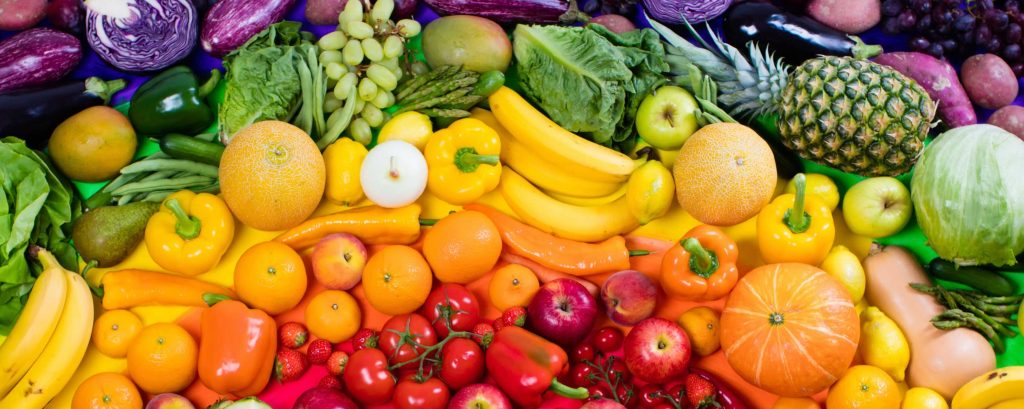We all know that fruits and vegetables are good for our health because they have vitamins, minerals, and fibre.
But have you heard of their ‘phytonutrients’? That’s a group of compounds, which give plant-based foods their colour, flavour and smell.1
Over the last few years, the phrase “Eat the Rainbow” has been cropping up increasingly, referring to the colours found in fruits and vegetables. That’s because phytonutrients don’t just make plant foods look vibrant and taste good: they are also incredibly nutritious, for multiple reasons.
One of these is their antioxidant properties: they neutralise free radicals, which are the underlying cause of ageing and a number of diseases (eg. arthritis, cancers, atherosclerosis, Parkinson’s disease).2
There are many different types of phytonutrients; of them, carotenoids are the most widely known.
Carotenoids and the Body
Carotenoids comprise mainly yellow, orange, red and some green pigments. These benefit our body in their own ways.
A] Carotenoids & Eyesight:
As children, we were always told to eat our carrots as they would “protect our eyes”. There is some truth to this statement. Beta-carotene, one of the nutrition world’s more famous carotenoids, is the orange pigment found in carrots. This pigment is converted by our body to a form of vitamin A, which is especially important for vision in dim light.3
Lutein and zeaxanthin contribute to the colour of dark leafy greens. Together with beta-carotene, they filter harmful wavelengths of light, and act as antioxidants in the eyes, helping protect and maintain healthy cells.3
Apart from our eyesight, beta-carotene is also very important for our overall health, since vitamin A is considered to be the most multifunctional vitamin in the human body. It plays key roles in many other processes like reproduction, growth and development, immune competence, cell division, maintenance of tissue, and brain function.3,4
B] Carotenoids & Skin:
 Another carotenoid rapidly gaining fame is lycopene, which gives tomatoes and watermelons their red colour. One study compared the combined protective effects of lycopene and beta-carotene, the two most abundant carotenoids in human skin, and found that the body uses lycopene to neutralise free radicals, before it uses beta-carotene. This leaves the beta-carotene and the other antioxidants free to carry out their other benefits, keeping our skin healthier.5
Another carotenoid rapidly gaining fame is lycopene, which gives tomatoes and watermelons their red colour. One study compared the combined protective effects of lycopene and beta-carotene, the two most abundant carotenoids in human skin, and found that the body uses lycopene to neutralise free radicals, before it uses beta-carotene. This leaves the beta-carotene and the other antioxidants free to carry out their other benefits, keeping our skin healthier.5
Studies have even demonstrated that carotenoids play a role in attractiveness! A study reported that people perceived as healthy and more attractive had higher levels of carotenoids in their skin.6
Other Benefits:
Astaxanthin is a unique carotenoid because it penetrates into the cells of the body, and is believed to improved energy levels and fight fatigue by improving muscle endurance.7,8
Carotenoids are even being recognised for the way they help protect the heart, through their antioxidant activity, which may also be associated with improved cholesterol levels.3
Carotenoids and Heat
Many worry about fruits and vegetables losing their nutritional value when we cook them. Although several nutrients are very sensitive to heat, this isn’t necessarily true for carotenoids.9,10
When tomatoes are cooked, the lycopene in them undergoes a structural change and is actually rendered more effective. Similarly, cooking carrots allows the body to absorb more beta-carotene.
That said, when you see yellows, oranges, reds and greens brightening up a salad, fruit bowl or grilled dish, filling up on each colour in any form is always a good idea!
References:
1. Pandey KB & Rizvi SI. Oxidative Medicine and Cellular Longevity 2009, 2(5): 270-278.
2. Beecher GR. Nutr Rev 1999, 57(9 Pt 2): S3-6.
3. Alvarez R, et al. Chem Rev 2014, 114(1): 1-125.
4. Litwack G. Vitamin A; Vitamins and Hormones, vol. 75. Elsevier: London, UK, 2007.
5. Ribaya-Mercado JD, et al. J Nutr 1995, 125(7): 1854-1859.
6. Stephen ID, et al. Evolution and Human Behavior 2011, 32(3): 216-227.
7. Bagchi D, et al. Nutrition and Enhanced Sports Performance: Muscle Building, Endurance, and Strength. Elsevier Science, 2013.
8. Nishida Y, et al. Carotenoid Science 2007, 11: 16-20.
9. Rodriguez-Amaya DB. Food Carotenoids: Chemistry, Biology and Technology. Wiley, 2015.
10. van Het Hof KH, et al. J Nutr 2000, 130(3): 503-506.




Leave a comment